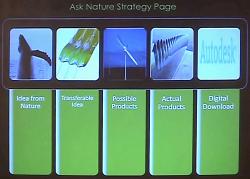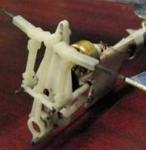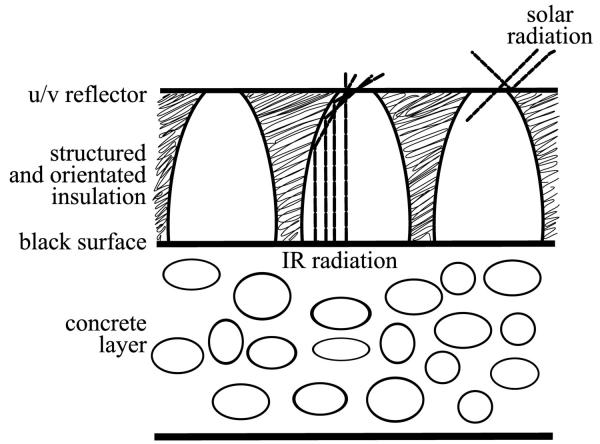NSF Bio-Inspired Design Workshop (Norbert Hoeller)
2012/01/21 corrected links to Vincent and Rosen video
Through the efforts of Ashok Goel (Georgia Tech), Dan McAdams (Texas A&M) and Rob Stone (Oregon State), the first NSF-funded Bio-Inspired Design Workshop was held in Palo Alto on March 20, 2011. The theme was Charting a Course for Computer-Aided Bio-Inspired Design Research, bringing together 34 members of the bio-inspired design research community to explore how we can "systematically mine biological knowledge to solve existing engineering problems".
The goals of the workshop included improving communication amongst the diverse groups involved in bio-inspired design, exploring how biological phenomena can influence design in the areas of sustainability and complex systems, and accelerating the transition from research to practice. Deliverables included recommendations to NSF for future funding and programs, establishing a community of researchers and publishing a book on Biologically Inspired Design: Computational Methods and Tools. A follow-on workshop is planned for August.
The workshop covered a wealth of material that cannot be adequately summarized here - links to the presentations and video clips can be found at the end of the article. Below are a few presentations of particular interest to designers.
Biomimicry: Sustainable Design Inspired by Nature (Janine Benyus)
The keynote address by Janine Benyus provided an overview of the biomimicry approach, the shift from focusing largely on design to including decision and policy making, and the key role of the Biomimicry Guild and Institute in making biological information visible to designers by delivering concepts, developing tools and nurturing communities.
 For example, AskNature is a tool that organizes biological content by function, incorporates a taxonomy to help designers explore concepts and includes social networking capabilities. The Biomimicry Group is working with Autodesk on redesigning AskNature around a model of:
For example, AskNature is a tool that organizes biological content by function, incorporates a taxonomy to help designers explore concepts and includes social networking capabilities. The Biomimicry Group is working with Autodesk on redesigning AskNature around a model of:
- capturing ideas from nature,
- identifying how they are transferable and what benefits they provide,
- cataloging possible and actual products,
- incorporating digitally downloadable material that can be imported into design applications.
 Janine described the Ecological Performance Standards process that challenges designers to develop solutions as good as or even better than the ecological services delivered by the native ecosystem. The challenge is to identify the relevant functions and then mine the literature to find locally-specific metrics in a language that is meaningful to designers.
Janine described the Ecological Performance Standards process that challenges designers to develop solutions as good as or even better than the ecological services delivered by the native ecosystem. The challenge is to identify the relevant functions and then mine the literature to find locally-specific metrics in a language that is meaningful to designers.
Janine also touched on the advances in 3D manufacturing and the potential for developing a structure-function catalog so that designers can make better decisions about the materials used in the manufacturing process as well as how those materials can be structured.
Bio-Inspired Robotics (S.K. Gupta)
Satyandra Gupta has used design of bio-inspired robotics to help engineering students gain a greater appreciation of engineering principles. He has found the following approaches to be useful in developing effective designs:
- simplify what has been learned from nature to identify the high value features and characteristics,
- amplify selected biological characteristics beyond what is found in nature to enhance performance.
 For example, when studying natural analogies for Miniature Air Vehicles (MAVs), the complexity of tail motion makes both analysis and implementation of the required actuators challenging. Instead, the flexibility of the wings was amplified to provide both greater performance and finer control. Modeling and simulation are essential to properly understanding how natural systems work. Again, it is essential to simplify and reduce the models to the essential elements and then combine the components into a meta-model which guides the design process.
For example, when studying natural analogies for Miniature Air Vehicles (MAVs), the complexity of tail motion makes both analysis and implementation of the required actuators challenging. Instead, the flexibility of the wings was amplified to provide both greater performance and finer control. Modeling and simulation are essential to properly understanding how natural systems work. Again, it is essential to simplify and reduce the models to the essential elements and then combine the components into a meta-model which guides the design process.

 Satyandra ended the talk with a discussion of advanced manufacturing methods that enable production of very small assemblies, including in-mold assembly, sequential molding of multiple materials and compliant joints. These techniques enabled manufacturing of a flapping wing Small Bird MAV weighing 15.4 g carrying a 5.7 g payload in a 5 minute flight. Video clips are available on the Maryland Robotics Center website.
Satyandra ended the talk with a discussion of advanced manufacturing methods that enable production of very small assemblies, including in-mold assembly, sequential molding of multiple materials and compliant joints. These techniques enabled manufacturing of a flapping wing Small Bird MAV weighing 15.4 g carrying a 5.7 g payload in a 5 minute flight. Video clips are available on the Maryland Robotics Center website.
Understanding Biomechanics to Find Gaps in Technology (Julian Vincent) Julian Vincent described his research into the different pathways used by technology and nature to solve problems. Whereas we emphasize energy and substance, nature tends to use information and structure while minimizing the amount of energy required (see Biomimetics: its practice and theory for more details). At a high level, these differences can challenge designers to look for alternative and better solutions.
Julian Vincent described his research into the different pathways used by technology and nature to solve problems. Whereas we emphasize energy and substance, nature tends to use information and structure while minimizing the amount of energy required (see Biomimetics: its practice and theory for more details). At a high level, these differences can challenge designers to look for alternative and better solutions.
Salmaan Craig designed a roof insulation for hot desert climates that uses structure and information to cool without expending energy on traditional air conditioning. The design actively cool the buildings by relying on the characteristics of shortwave inbound solar radiation compared to infra-red radiation emitted by objects. Reflective cones molded into the insulation concentrate and guide infra-red radiation emitted by the concrete layer into space (radiative cooling). The small openings in the top of the insulation are covered with shortwave reflective coatings which effectively block solar radiation from penetrating the insulation. The structure of the insulation does not significantly affect its ability to block convective heat gain from the environment.
Starting with the Russian TRIZ (Theory of Inventive Problem Solving) framework, Julian and his team have developed a more granular tool that maps transformations between six operation fields to the TRIZ 40 Inventive principles for both technological (PRIZM) and biological solutions (BioTRIZ). The difference between the two matrices can be used to identify areas where biological principles are likely to suggest solutions different from those we are familiar with.
Julian is currently developing an ontology of biomimetics using Protégé to organize biological information and analyze relationships. The results largely confirm the PRIZM/BioTRIZ research while pointing out specific biological principles requiring additional research. Protégé is a free, open source ontology editor and knowledge base framework developed by Stanford University for the semantic web. Once installed, Protégé can be used to download a copy of the ontology that can be browsed, searched, analyzed and updated.
Breakout Session: BID and Sustainability (Mary Lou Maher)
The session participants wanted to increase the overlap between the domains of bio-inspired design and sustainable design by reaching out to the sustainability community, using analogies from nature at deeper levels (process and system), and building sustainability into analogical models.
Key research areas discussed:
- We need to refine the list of biologically inspired principles of biological design, map them to more granular specifications and design constraints, integrate them into design tools and emphasize the (eco-)systems aspects of sustainability.
- We need to ensure that methods and tools (such as analogical reasoning, evaluation, knowledge representation and models, and information repositories) emphasize bio-inspired sustainable design
- We need to focus on policy and culture change by including social scientists in our research projects, investigating what it takes to shift from a short-term to long-term focus, and establishing a wide set of ‘good design’ criteria beyond cost and efficiency.
Breakout Session: BID and Complex Systems (Jami Shah)
The session participants began by identifying the characteristics of complex engineered and biological systems. Complex systems typically have many parts and heterogeneous interactions. Although the individual units may be relatively simple, the systems they comprise can exhibit emergent behavior. Complex systems are often hierarchical, span multiple scales, are not at equilibrium and display non-linear responses. Our lack of understanding and limited measurement capabilities can lead to a degree of uncertainty and irreducible (probabilistic) descriptions.
Understanding how nature deals with complexity can help us cope with complex engineering systems that we cannot completely describe. It can lead to more innovative products and elegant designs that deliver the same function in a less complex way. Reducing uncertainty is important – we need to be able to predict the behavior and performance of solutions.
Some of the ways nature deals with complexity include: ability to self-repair, adaptability, redundancy (has different meanings for engineers and biologists), failure accommodation, regeneration (regenerated structures can be stronger as a result of failure), multi-functionality, reconfigurability, swarm behavior, robustness and resilience.
Key research areas include:
- Are there general principles for resolving conflicts between multiple objectives that could lead to greater efficiency and effectiveness?
- How does learning take place in complex biological systems?
- How can we better enable two-way collaboration between biologists and engineers, deepening our understanding of biological systems while we create innovative designs that test the principles?
- How do we increase our knowledge of ecosystems and make that information available to designers?
- What are the general principles underlying hierarchies in nature and how can they be applied to design?
- How will a design model based on evolution need to change as we increase the rate of transformation?
Breakout Session: BID and Design Education (Craig Tovey)
The session participants recommended that NSF fund:
- A set of peer-reviewed modules at different levels of sophistication, supporting collaborative education, and linked to specific learning objectives (support novel design techniques, interdisciplinary communication and collaboration, flow of knowledge across domain boundaries, awareness of design as taking place within a system).
- Development of computational and other tools, including function-based databases, design tools with integrated biological content, computer support for collaboration and bio-inspired design cognitive processes.
- Research on whether and how bio-inspired design effectively accomplishes the specific learning objectives.
-
Research to demonstrate the benefits of bio-inspired design for:
- biologists (broader benefits/purpose of biological knowledge, access to modeling and analysis methods/tools from physical sciences),
- designers (greater innovation, improved sustainability).
- Research in the best pathways to developing innovative bio-inspired products.
Workshop Presentations (PDF Presentations and Video Clips):
The video clips can be downloaded or streamed using Apple QuickTime or the open source VLC media player.
Session I: Chair: Robert Stone (Video)
- Janine Benyus, “Biomimicry: Sustainable Design Inspired by Nature” (Video)
- Satyandra Gupta, “Bio-Inspired Robotics” (Video)
- Dan McAdams, “Bioinspired Design” (Video)
- Ashok Goel, “Computational Methods and Tools for Biologically Inspired Design” (Video)
Session II: Chair: Dan McAdams
- Julian Vincent, Workshop Talk (Video)
- David Rosen, “SSS Approach and Creativity Metrics for Bio-Inspired Design” (Video)
- Shapour Azarm, “Bio-Inspired Design Optimization” (Video)
- Thomasz Arciszewski, “Bioinspiration” (Video)
- Jeannette Yen, “Center for Biologically-Inspired Design” (Video)
Session III: Chair: Ashok Goel
- Amaresh Chakrabarti, “Biologically Inspired Design: An Overview of Research at IdeasLab, IISc” (Video)
- Breakout session charge (Video)
Session IV: Chair: Robert Stone
-
Breakout session reports:
- If BID is going to contribute to sustainability it needs to… (Led by Mary Lou Maher) (Video)
- If BID is going to contribute to complex systems design it needs to… (Led by Jami Shah) (Video)
- If BID is going to contribute to design education and pedagogy it needs to… (Led by Craig Tovey) (Video)
- Closing Remarks (Video)
Image Credits:
- Tree in Test Tube: © INFINITY - Fotolia.com
- AskNature Strategy and New Standards: The Biomimicry Group
- MAV and components: S.K. Gupta (University of Maryland)
- Making/Becoming and Roof Insulation: Julian Vincent


